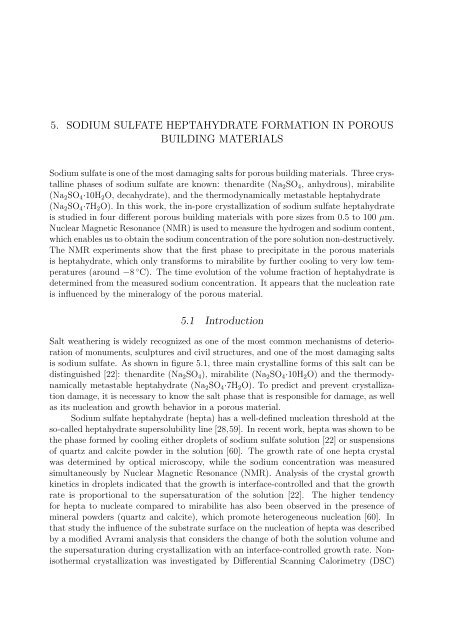P - Technische Universiteit Eindhoven
P - Technische Universiteit Eindhoven
P - Technische Universiteit Eindhoven
Create successful ePaper yourself
Turn your PDF publications into a flip-book with our unique Google optimized e-Paper software.
5. SODIUM SULFATE HEPTAHYDRATE FORMATION IN POROUS<br />
BUILDING MATERIALS<br />
Sodium sulfate is one of the most damaging salts for porous building materials. Three crystalline<br />
phases of sodium sulfate are known: thenardite (Na 2 SO 4 , anhydrous), mirabilite<br />
(Na 2 SO 4·10H 2 O, decahydrate), and the thermodynamically metastable heptahydrate<br />
(Na 2 SO 4·7H 2 O). In this work, the in-pore crystallization of sodium sulfate heptahydrate<br />
is studied in four different porous building materials with pore sizes from 0.5 to 100 µm.<br />
Nuclear Magnetic Resonance (NMR) is used to measure the hydrogen and sodium content,<br />
which enables us to obtain the sodium concentration of the pore solution non-destructively.<br />
The NMR experiments show that the first phase to precipitate in the porous materials<br />
is heptahydrate, which only transforms to mirabilite by further cooling to very low temperatures<br />
(around −8 ◦ C). The time evolution of the volume fraction of heptahydrate is<br />
determined from the measured sodium concentration. It appears that the nucleation rate<br />
is influenced by the mineralogy of the porous material.<br />
5.1 Introduction<br />
Salt weathering is widely recognized as one of the most common mechanisms of deterioration<br />
of monuments, sculptures and civil structures, and one of the most damaging salts<br />
is sodium sulfate. As shown in figure 5.1, three main crystalline forms of this salt can be<br />
distinguished [22]: thenardite (Na 2 SO 4 ), mirabilite (Na 2 SO 4·10H 2 O) and the thermodynamically<br />
metastable heptahydrate (Na 2 SO 4·7H 2 O). To predict and prevent crystallization<br />
damage, it is necessary to know the salt phase that is responsible for damage, as well<br />
as its nucleation and growth behavior in a porous material.<br />
Sodium sulfate heptahydrate (hepta) has a well-defined nucleation threshold at the<br />
so-called heptahydrate supersolubility line [28,59]. In recent work, hepta was shown to be<br />
the phase formed by cooling either droplets of sodium sulfate solution [22] or suspensions<br />
of quartz and calcite powder in the solution [60]. The growth rate of one hepta crystal<br />
was determined by optical microscopy, while the sodium concentration was measured<br />
simultaneously by Nuclear Magnetic Resonance (NMR). Analysis of the crystal growth<br />
kinetics in droplets indicated that the growth is interface-controlled and that the growth<br />
rate is proportional to the supersaturation of the solution [22]. The higher tendency<br />
for hepta to nucleate compared to mirabilite has also been observed in the presence of<br />
mineral powders (quartz and calcite), which promote heterogeneous nucleation [60]. In<br />
that study the influence of the substrate surface on the nucleation of hepta was described<br />
by a modified Avrami analysis that considers the change of both the solution volume and<br />
the supersaturation during crystallization with an interface-controlled growth rate. Nonisothermal<br />
crystallization was investigated by Differential Scanning Calorimetry (DSC)
















